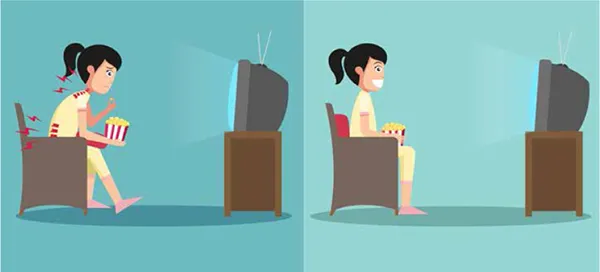![]()
Chapter 1
The Sitting Problem
Work
On average, desk workers spend around ten hours a day sitting.16 This accounts for 86% of American workers who utilize a chair in the office. As technology advances, so does the demand for desk work, increasing the number of individuals reporting chronic back pain and health issues related to a sedentary lifestyle. These health issues include diabetes, hypertension, depression, and muscle soreness.
Unfortunately, in addition to the adverse health effects of prolonged sitting listed above, many individuals tend to sit with one leg crossed over the other, which causes more health issues and can lead to long-term damage. One article by the Journal of Physical Therapy Science explained that “sitting with the legs crossed may alter the weight-bearing or loads on soft tissues and muscles, resulting in unstable postures.”24 This sitting position can lead to improper alignment of the body, causing compensation to occur in order to maintain stability. An example of this is the way the pelvis rotates when forced into a cross-legged position, which can lead to problems in the lumbar spine region.
The image to the right gives a good idea of the proper seated position while working at a desk. However, as the day goes on, it is likely that individuals in this position will begin to experience muscle fatigue in the areas responsible for keeping the body in proper sitting form, causing their posture to change and move into a more slouched postural position.
Cars
One study found that sitting in a car may be contributing to your heart problems. Men who spend over ten hours a week riding in a car had an 82% greater risk of suffering from heart disease than those who spent less time in the car.16 The study found that “longer driving time was associated with higher odds of smoking, insufficient physical activity, short sleep, obesity, and worse physical and mental health.”25 In fact, the same study found that each hour spent in a car correlated with a 6% increase in obesity. When sitting in a car, try to mimic your posture to the young woman in the photo to the right. She is sitting up straight, keeping her arms in front, and looking straight ahead.
Video Games
In 2014, Nielsen explained that “players aged 13 and over spend more than six hours a week on any gaming platform.”18 In fact, 63% of households have at least one person who plays video games regularly in the United States.26 Surprisingly, only 27% of gamers are under 18 years of age, and 26% are 50 years or older, with 35 years being the average age of the gamer.26
It is no surprise, however, that those who play video games are typically seated. If added to the amount of time seated at school or work, riding in a car, and eating meals, those six hours may be taking away from time spent moving. Another factor to consider is the posture of the gamers. When your character, spaceship, or race car is winning the game, your posture may not seem nearly as pertinent until your back begins to ache and suddenly your reaction time to the game slows down.
Television
Whether sitting at home streaming your favorite show or at a theater to see the latest movie, much of the influence to sit comes from television. Statistically, adults watch on average more than five hours of television a day.20 A study found that men who spend over ten hours a week watching television had a 64% greater chance of suffering from heart disease.16 In fact, the British Journal of Sports Medicine found that “every hour of television watched may reduce our lifespan by an average of 21.8 minutes. Compare this health statistic to smoking a cigarette, which reduces our lifespan by an average of 11 minutes17 Unfortunately, children are also highly affected by the sitting disease. A study done by Preventative Medicine Reports explained that children who watch television for more than three hours a day “have a 65% higher chance of being obese compared to children who watch less than one hour of TV per day.”19
![]()
Chapter 2
The Effects of Sitting on Your Body
The body is very specific in how it likes to be positioned and how long it likes to be stationary. Any deviation from the body's normal demands can lead to negative symptoms and cause a great deal of stress both physically and mentally. Therefore, understanding the musculoskeletal system and its supporting parts is helpful in keeping the body in adequate condition. As the name implies, the musculoskeletal system encompasses the muscular system and the skeletal system of the human anatomy. This complicated system includes other structures of the body, such as ligaments, tendons, cartilage, joints, and tissues that all work together to maintain a healthy body. Unfortunately, this also means that when one part of the system has problems, other areas of the body are more likely at risk. This chapter will outline the impact sitting and sedentary behavior has on the musculoskeletal system.1
Bones
Bones are primarily made up of collagen and calcium. This combination accounts for the strength and flexibility of the bones to uphold the structure of the body. In order to maintain and build bone health, it is important to maintain a proper diet and incorporate strengthening practices into your daily routine. If ignored, the bones may become weak and unable to support the weight and movement of the body.
Prolonged sitting is associated with lower bone density, which can lead to osteoporosis due to an inhibition of bone growth factors. In fact, women can lose up to 1% of bone mass per year by sitting for more than six hours a day. In addition, misalignment of the skeleton can occur, leading to an abnormal curvature of the spine and an increased risk of chronic pain.
Muscles
Unused and weak muscles leave joints unstable and prone to injury and chronic pain. During sitting, glute, hip, back, and shoulder muscles weaken from lack of use. This muscle weakness affects posture and balance, thus making it harder to move freely. If weight-bearing muscles infrequently activate, adverse back curvature may become an issue. While there is a large number of specific muscles affected by sitting and inactivity, certain ones are affected more than others. These muscle regions include the hip flexors, abdominals, back extensors, legs, and shoulders. While sitting, muscle action is replaced by the support of the chair, leading to weakness. This weakness from sitting may also lead to loss of sarcomere length, and thus decrease the ability of the muscle to powerfully contract.
Tendons and Ligaments
According to the National Federation of Professional Trainers, “muscle strength is limited by the ability of the tendon to handle the force generated by the muscle.”27 Ligaments are then relied on to stabilize joints as the force is applied. Needless to say, tendons (which connect muscle to bone) and ligaments (which connect bone to bone) play important roles in the muscle contraction process. When a muscle contracts, it pulls on the tendon, which then pulls on the bone and movement occurs. Since these three structures work together to perform a task, such as lifting a weight, it makes sense that weakened muscles can lead to weakened tendons and ligaments. In addition, tendons and ligaments are not able to heal from injuries as fast as muscles due to their lack of blood supply.
When we sit for long periods of time, our muscles, tendons, and ligaments may become tight. Not only can this cause stiffness within the joints, it can also potentially lead to injury. With little elasticity within the muscles, tendons, and ligaments, a simple movement can cause a strain or tear. Unfortunately, a seated position compromises the muscles, tendons, and ligaments located...







